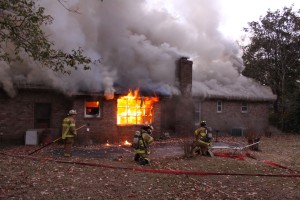Lorton, VA Fatal Fire Report is Out. STATter 911 has the Findings.
This afternoon STATter 911 received a copy of the Fairfax County Fire & Rescue Department’s “Post Incident Analysis” of the May 23rd fire in Lorton, Virginia that killed 49-year-old Debra Chiles. You may recall that Chiles had been on the phone with 911 workers for many minutes saying she was trapped in the third-floor bathroom. The report states that Chiles’ body wasn’t found for more than 40-minutes.
One week after the fire, then Interim Fire Chief David Rohr told STATter 911 that crews should have found Debra Chiles in the early stages of this fire. Chief Rohr was at a loss to explain why this did not happen. There are now some answers in the 14-page report. Deputy Chief John A. Burke led the team that compiled the report on the fire at 9207 Cardinal Forest Lane.
The report has not been officially released, but a spokesman for the department says he will attempt to make someone available tomorrow to discuss the findings. STATter 911 also plans to have a link where you will be able to read the entire report (I will get our web crew on that tomorrow). For now, here are the 10 findings from the report committee:
1. The response map did not provide an accurate depiction of the address. Specifically, it did not indicate this address was part of a back-to-back style townhouse.
2. The first arriving engine selected and advanced an attack line that was too long. Additionally, the excess hose was not properly flaked out. These actions resulted in a delay in applying water to the fire due to kinks and a lack of pressure at the nozzle.
3. The first-due engine did not provide a situation report to include a command statement. Critical information such as the back-to-back townhouse feature, confirmation from an occupant of a person trapped, initial actions and assignments, command statement, etc. would have provided other responders with critical information and would have provided a foundation upon which to manage the incident.
4. Initial ventilation operations were uncoordinated. R419 broke out a first-floor window without orders before the attack line and crew were prepared to make entry, which resulted in fire issuing from the front door and window. Ventilation must be coordinated and serve a purpose. At this event, in addition to coordinating ventilation with the attack line, upper windows could have been vented earlier to possibly provide relief to occupants remaining inside (venting for life). Subsequent ventilation by Truck 441’s outside crew was coordinated through the unit officer and Command and it was quite effective.
5. Units failed to follow their initial assignments based upon the order of dispatch. These actions resulted in confusion as to the location and tasks of several units. This includes the fact there was no initial RIT in place. At this event, the fourth-due engine company arrived second, initially positioned too close and had to back up, and then entered the building to conduct a primary search. No apparatus (engine or truck) positioned to cover Side C. Although the second truck handled all of the Side C duties and deployed the ground ladders, the truck was not positioned on Side C.
6. Primary search efforts were uncoordinated at the company and command level which resulted in overlapping primary searches. The result was that several crews repeatedly searched the same areas, often at the same time. This townhouse, like many structures, is too small to accommodate more than one crew per floor searching at a time.
7. Search efforts on the third floor were ineffective. The victim who died at this fire was found in a relatively small bathroom on the third floor. Despite statements from several personnel that they searched the bathroom–both physically and with thermal imagers–the victim was not located for over 40 minutes. The victim was located just inside the bathroom. There were no obstructions or obstacles to hinder locating her.
8. Crews inaccurately interpreted the fire conditions. R419 entered the front door with E419’s crew, but then determined the conditions were too hazardous and the rescue crew withdrew; the engine crew was not withdrawn. Fire investigator’s determined during their investigation of the incident that the fire was in the free-burning stage with relatively low heat above the first floor. Heat and smoke demarcation indicators were approximately three feet off the floor outside the first-floor kitchen area.
9. Crew integrity was not maintained. R419’s crew was split into two teams to conduct searches of the exposures after the officer determined that the fire building was too dangerous; these teams did not remain intact. Following searches of the exposures, three members of the crew re-entered the fire building. However, one crew member did not enter with the rest of the crew. R419’s officer was unaware that R419’s full crew was not present. The fourth crew member, after realizing the crew was no longer in front of the building, decided to enter the building to search for them. The crew member located another crew on the first floor and remained with that crew until the remainder of R419’s crew was observed exiting the structure following their search of the third floor.
10. Not all SCBA voice amplifiers were turned on which impaired voice communications.
The findings from this incident will be incorporated into future firefighter training.
Audio of radio traffic and 911 calls from this fire can be found here.
For our May 30th report with Chief Rohr and a timeline, look here.


